MITSUBISHI GRANDIS 2010 Owner's Manual (in English)
Manufacturer: MITSUBISHI, Model Year: 2010, Model line: GRANDIS, Model: MITSUBISHI GRANDIS 2010Pages: 273, PDF Size: 21.01 MB
Page 221 of 273
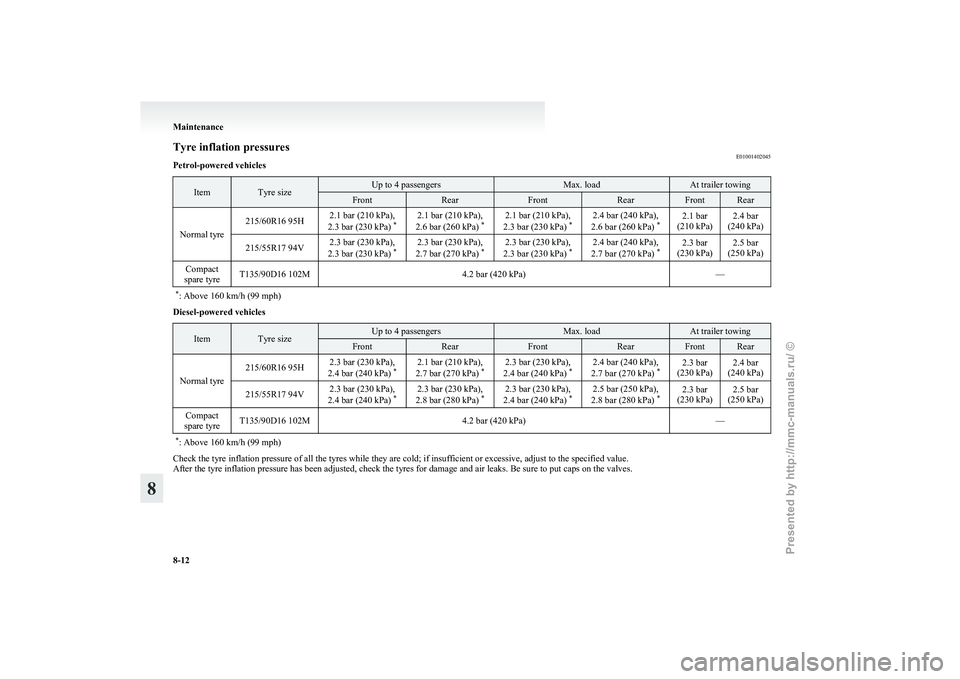
Tyre inflation pressures
E01001402045
Petrol-powered vehicles Item Tyre size Up to 4 passengers Max. load At trailer towing
Front Rear Front Rear Front Rear
Normal tyre 215/60R16 95H
2.1 bar (210 kPa),
2.3 bar (230 kPa) *2.1 bar (210 kPa),
2.6 bar (260 kPa) *2.1 bar (210 kPa),
2.3 bar (230 kPa) *2.4 bar (240 kPa),
2.6 bar (260 kPa) *2.1 bar
(210 kPa) 2.4 bar
(240 kPa)
215/55R17 94V 2.3 bar (230 kPa),
2.3 bar (230 kPa) *2.3 bar (230 kPa),
2.7 bar (270 kPa) *2.3 bar (230 kPa),
2.3 bar (230 kPa) *2.4 bar (240 kPa),
2.7 bar (270 kPa) *2.3 bar
(230 kPa) 2.5 bar
(250 kPa)
Compact
spare tyre T135/90D16 102M
4.2 bar (420 kPa) —
* : Above 160 km/h (99 mph) Diesel-powered vehicles
Item Tyre size Up to 4 passengers Max. load At trailer towing
Front Rear Front Rear Front Rear
Normal tyre 215/60R16 95H
2.3 bar (230 kPa),
2.4 bar (240 kPa) *2.1 bar (210 kPa),
2.7 bar (270 kPa) *2.3 bar (230 kPa),
2.4 bar (240 kPa) *2.4 bar (240 kPa),
2.7 bar (270 kPa) *2.3 bar
(230 kPa) 2.4 bar
(240 kPa)
215/55R17 94V 2.3 bar (230 kPa),
2.4 bar (240 kPa) *2.3 bar (230 kPa),
2.8 bar (280 kPa) *2.3 bar (230 kPa),
2.4 bar (240 kPa) *2.5 bar (250 kPa),
2.8 bar (280 kPa) *2.3 bar
(230 kPa) 2.5 bar
(250 kPa)
Compact
spare tyre T135/90D16 102M
4.2 bar (420 kPa) —
* : Above 160 km/h (99 mph) Check the tyre inflation pressure of all the tyres while they are cold; if insufficient or excessive, adjust to the specified value.
After the tyre inflation pressure has been adjusted, check the tyres for damage and air leaks. Be sure to put caps on the valves.Maintenance
8-12
8
Presented by http://mmc-manuals.ru/ \251
Page 222 of 273
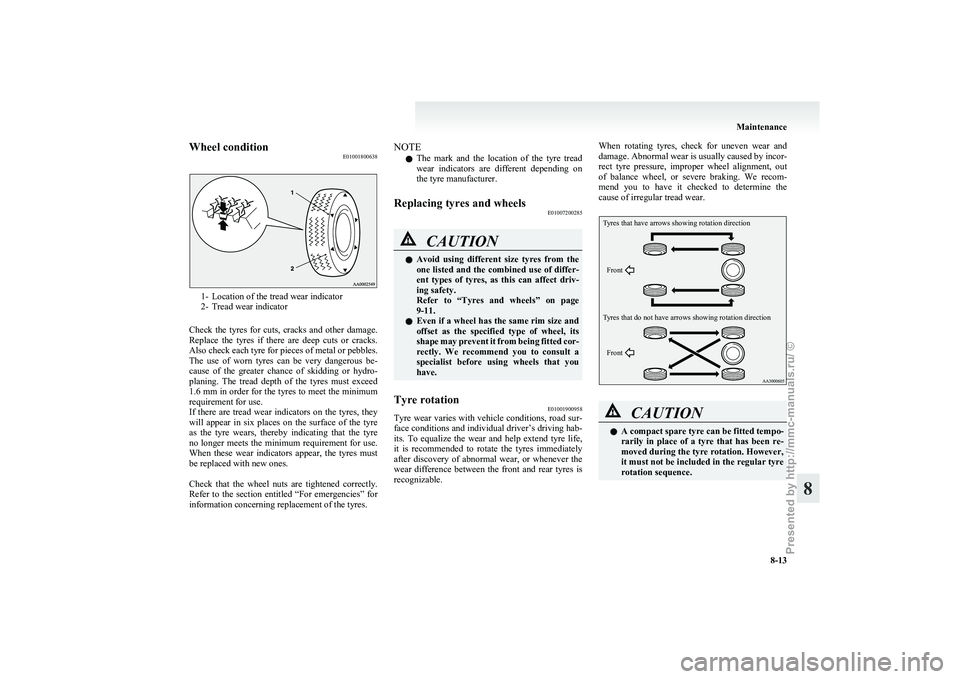
Wheel condition
E010018006381- Location of the tread wear indicator
2-
Tread wear indicator
Check the tyres for cuts, cracks and other damage.
Replace the tyres if there are deep cuts or cracks.
Also check each tyre for pieces of metal or pebbles.
The use of worn tyres can be very dangerous be-
cause of the greater chance of skidding or hydro-
planing. The tread depth of the tyres must exceed
1.6 mm in order for the tyres to meet the minimum
requirement for use.
If there are tread wear indicators on the tyres, they
will appear in six places on the surface of the tyre
as the tyre wears, thereby indicating that the tyre
no longer meets the minimum requirement for use.
When these wear indicators appear, the tyres must
be replaced with new ones.
Check that the wheel nuts are tightened correctly.
Refer to the section entitled “For emergencies” for
information concerning replacement of the tyres. NOTE
l The
mark and the location of the tyre tread
wear indicators are different depending on
the tyre manufacturer.
Replacing tyres and wheels E01007200285 CAUTION
l
Avoid
using different size tyres from the
one listed and the combined use of differ-
ent types of tyres, as this can affect driv-
ing safety.
Refer to “Tyres and wheels” on page
9-11.
l Even if a wheel has the same rim size and
offset as the specified type of wheel, its
shape may prevent it from being fitted cor-
rectly. We recommend you to consult a
specialist before using wheels that you
have.
Tyre rotation E01001900958
Tyre wear varies with vehicle conditions, road sur-
face
conditions and individual driver’s driving hab-
its. To equalize the wear and help extend tyre life,
it is recommended to rotate the tyres immediately
after discovery of abnormal wear, or whenever the
wear difference between the front and rear tyres is
recognizable. When rotating tyres, check for uneven wear and
damage.
Abnormal wear is usually caused by incor-
rect tyre pressure, improper wheel alignment, out
of balance wheel, or severe braking. We recom-
mend you to have it checked to determine the
cause of irregular tread wear.
Tyres that have arrows showing rotation direction
Front
Tyres that do not have arrows showing rotation direction Front CAUTION
l
A
compact spare tyre can be fitted tempo-
rarily in place of a tyre that has been re-
moved during the tyre rotation. However,
it must not be included in the regular tyre
rotation sequence. Maintenance
8-13 8
Presented by http://mmc-manuals.ru/ \251
Page 223 of 273

CAUTION
l
If the tyres have arrows (A) indicating
the correct direction of rotation, swap the
front and rear wheels on the left hand
side of the vehicle and the front and rear
wheels on the right hand side of the vehi-
cle separately. Keep each tyre on its origi-
nal side of the vehicle. When fitting the
tyres, make sure the arrows point in the
direction in which the wheels will turn
when the vehicle moves forward. Any
tyre whose arrow points in the wrong di-
rection will not perform to its full poten-
tial.
Front CAUTION
l
Avoid
the combined use of different types
of tyres.
Using different types of tyres can affect ve-
hicle performance and safety. Snow tyres
E01002000725
The
use of snow tyres is recommended for driving
on snow and ice. To preserve driving stability,
mount snow tyres of the same size and tread pat-
tern on all 4 wheels.
Snow tyres worn more than 50% are no longer suit-
able for use as snow tyres.
Snow tyres which do not meet specifications must
not be used. CAUTION
l
Observe
permissable maximum speed for
your snow tyres and the legal speed limit.
NOTE l The
laws and regulations concerning snow
tyres (driving speed, required use, type, etc.)
vary. Find out and follow the laws and regu-
lations in the area you intend to drive.
l If flange nuts are used on your vehicle,
change to tapered nuts when steel wheels are
used.
Tyre chains E01002101130
If tyre chains have to be used, ensure that they are
fitted only on the drive wheels (front).
Use
only tyre chains which are designed for use
with the tyres mounted on the vehicle: use of the in-
correct size or type of chain could result in damage
to the vehicle body.
Before fitting tyre chains, We recommend you to
consult a MITSUBISHI MOTORS Authorized Serv-
ice Point. Tyre size Wheel size Max chain
height[mm]
215/60R16 16x6.5 JJ 9
215/55R17 17x7.0 J The speed limit for tyre chain is 50 km/h (30
mph)
and remove the tyre chains as soon as possible on
snow free roads. WARNING
l DO
NOT use a jack when fitting the
chains, as in thsee conditions, the tyres
may slip on the icy road causing the vehi-
cle to slip off the jack. CAUTION
l
Practice
fitting the chains before you
need them.
Don’t expect help from other people in
the cold.
l Choose a clear straight stretch of road
where you can pull over and still be seen
while you are fitting the chains.
l Do not fit chains before you need them.
This will wear out your tyres and the
road surface.
l After driving around 100-300 metres,
stop and retighten the chains.
l Care should be taken with extremes of
steering lock to prevent possible contact
between the chains and the vehicle body. Maintenance
8-14
8
Presented by http://mmc-manuals.ru/ \251
Page 224 of 273
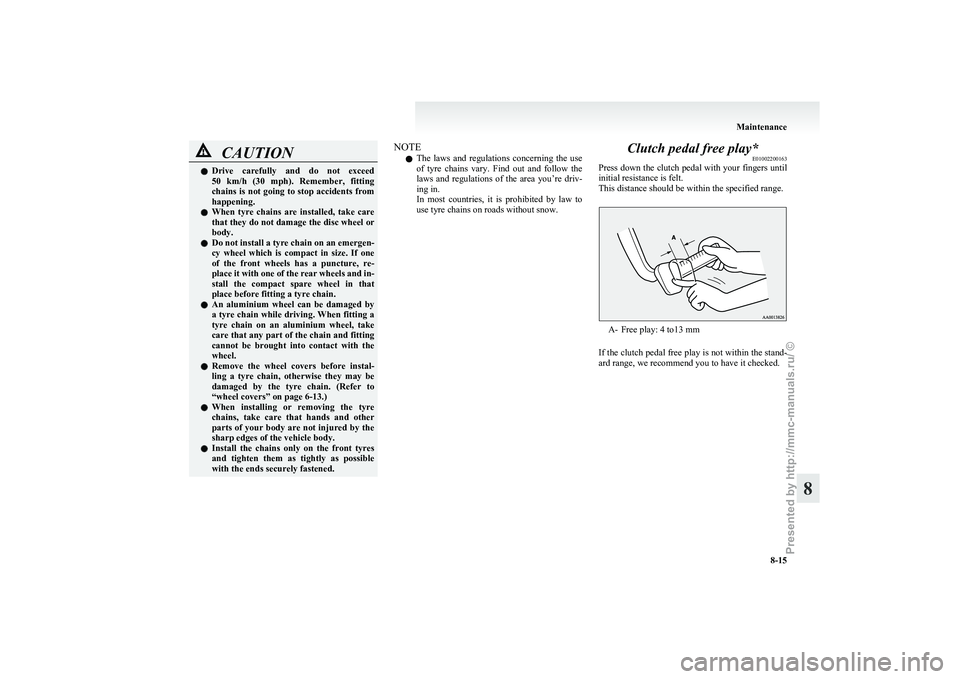
CAUTION
l
Drive carefully and do not exceed
50 km/h (30 mph). Remember, fitting
chains is not going to stop accidents from
happening.
l When tyre chains are installed, take care
that they do not damage the disc wheel or
body.
l Do not install a tyre chain on an emergen-
cy wheel which is compact in size. If one
of the front wheels has a puncture, re-
place it with one of the rear wheels and in-
stall the compact spare wheel in that
place before fitting a tyre chain.
l An aluminium wheel can be damaged by
a tyre chain while driving. When fitting a
tyre chain on an aluminium wheel, take
care that any part of the chain and fitting
cannot be brought into contact with the
wheel.
l Remove the wheel covers before instal-
ling a tyre chain, otherwise they may be
damaged by the tyre chain. (Refer to
“wheel covers” on page 6-13.)
l When installing or removing the tyre
chains, take care that hands and other
parts of your body are not injured by the
sharp edges of the vehicle body.
l Install the chains only on the front tyres
and tighten them as tightly as possible
with the ends securely fastened. NOTE
l The
laws and regulations concerning the use
of tyre chains vary. Find out and follow the
laws and regulations of the area you’re driv-
ing in.
In most countries, it is prohibited by law to
use tyre chains on roads without snow. Clutch pedal free play*
E01002200163
Press
down the clutch pedal with your fingers until
initial resistance is felt.
This distance should be within the specified range. A- Free play: 4 to13 mm
If
the clutch pedal free play is not within the stand-
ard range, we recommend you to have it checked. Maintenance
8-15 8
Presented by http://mmc-manuals.ru/ \251
Page 225 of 273
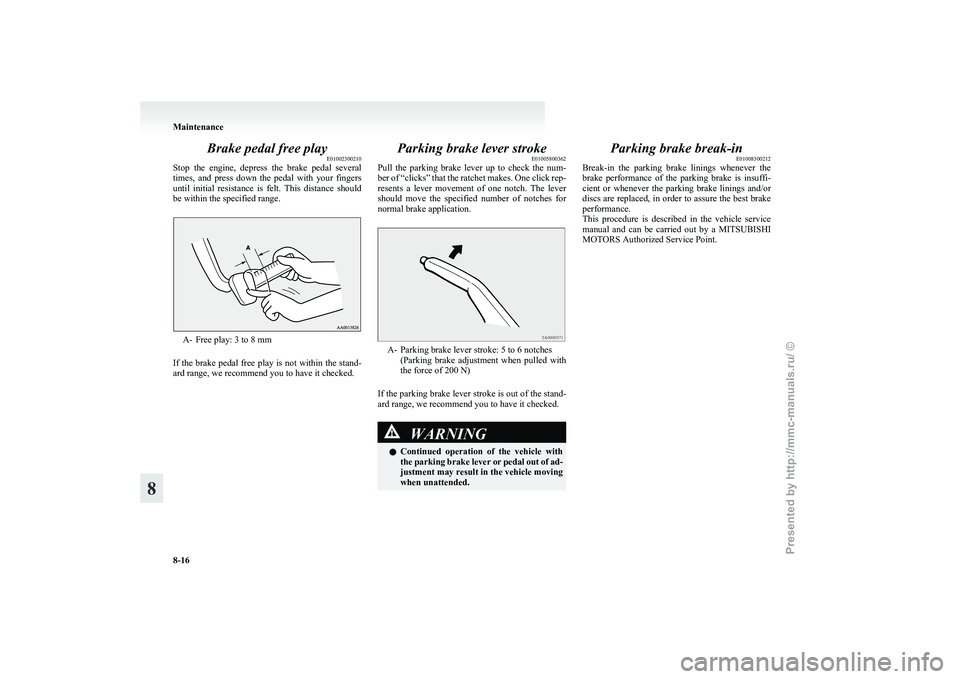
Brake pedal free play
E01002300210
Stop
the engine, depress the brake pedal several
times, and press down the pedal with your fingers
until initial resistance is felt. This distance should
be within the specified range. A- Free play: 3 to 8 mm
If
the brake pedal free play is not within the stand-
ard range, we recommend you to have it checked. Parking brake lever stroke
E01005800362
Pull
the parking brake lever up to check the num-
ber of “clicks” that the ratchet makes. One click rep-
resents a lever movement of one notch. The lever
should move the specified number of notches for
normal brake application. A- Parking brake lever stroke: 5 to 6 notches
(Parking
brake adjustment when pulled with
the force of 200 N)
If the parking brake lever stroke is out of the stand-
ard range, we recommend you to have it checked. WARNING
l Continued
operation of the vehicle with
the parking brake lever or pedal out of ad-
justment may result in the vehicle moving
when unattended. Parking brake break-in
E01008300212
Break-in
the parking brake linings whenever the
brake performance of the parking brake is insuffi-
cient or whenever the parking brake linings and/or
discs are replaced, in order to assure the best brake
performance.
This procedure is described in the vehicle service
manual and can be carried out by a MITSUBISHI
MOTORS Authorized Service Point. Maintenance
8-16
8
Presented by http://mmc-manuals.ru/ \251
Page 226 of 273
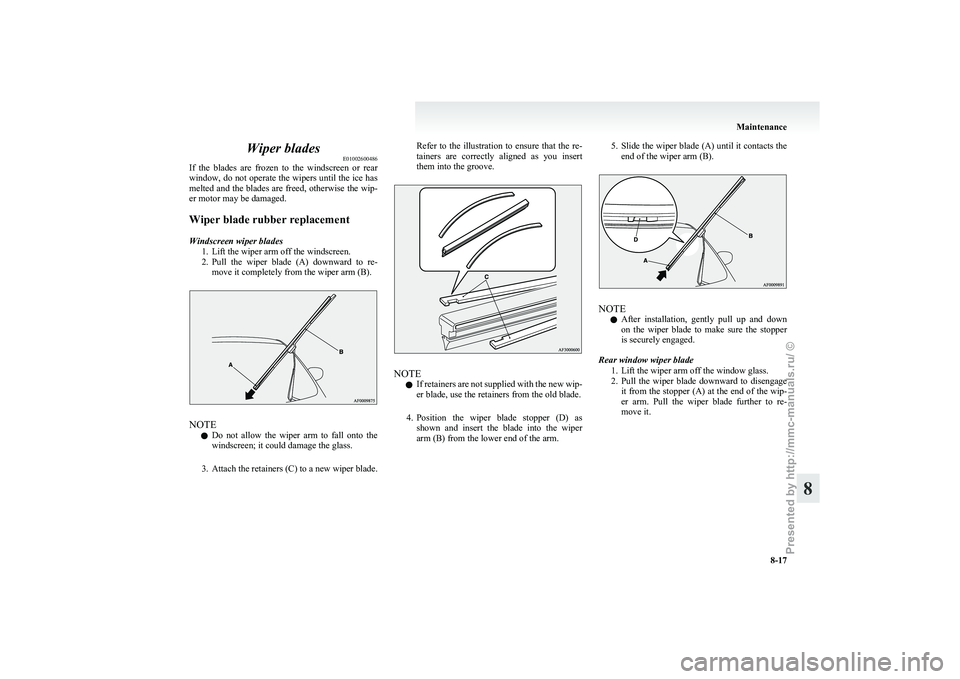
Wiper blades
E01002600486
If
the blades are frozen to the windscreen or rear
window, do not operate the wipers until the ice has
melted and the blades are freed, otherwise the wip-
er motor may be damaged.
Wiper blade rubber replacement
Windscreen wiper blades
1. Lift the wiper arm off the windscreen.
2. Pull the wiper blade (A) downward to re-move it completely from the wiper arm (B). NOTE
l Do
not allow the wiper arm to fall onto the
windscreen; it could damage the glass.
3. Attach the retainers (C) to a new wiper blade. Refer to the illustration to ensure that the re-
tainers
are correctly aligned as you insert
them into the groove. NOTE
l If
retainers are not supplied with the new wip-
er blade, use the retainers from the old blade.
4. Position the wiper blade stopper (D) as shown and insert the blade into the wiper
arm (B) from the lower end of the arm. 5. Slide
the wiper blade (A) until it contacts the
end of the wiper arm (B). NOTE
l After
installation, gently pull up and down
on the wiper blade to make sure the stopper
is securely engaged.
Rear window wiper blade 1. Lift the wiper arm off the window glass.
2. Pull the wiper blade downward to disengageit from the stopper (A) at the end of the wip-
er arm. Pull the wiper blade further to re-
move it. Maintenance
8-17 8
Presented by http://mmc-manuals.ru/ \251
Page 227 of 273
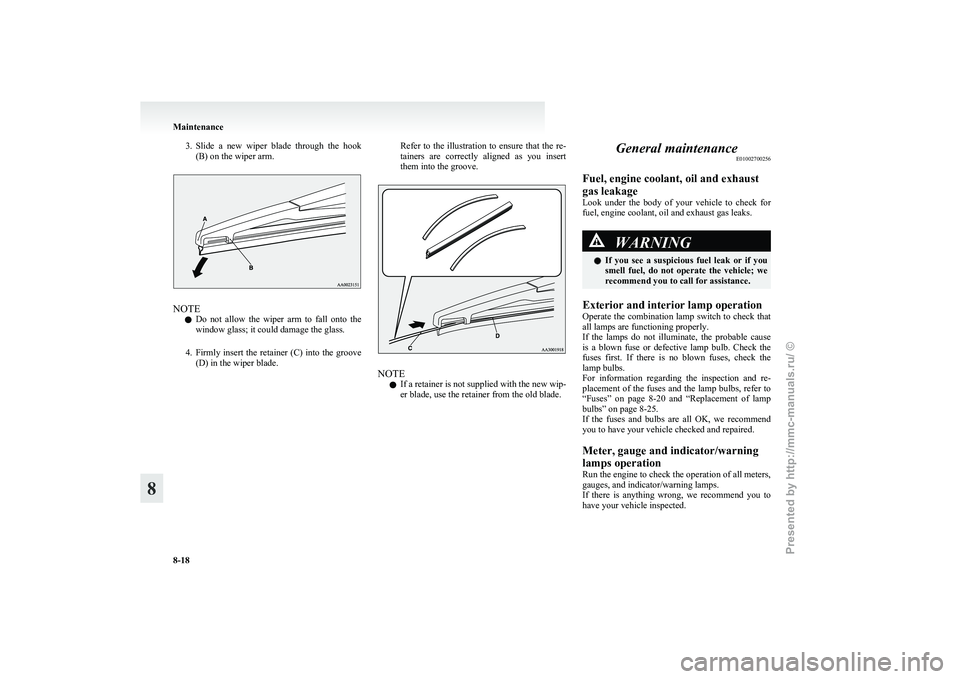
3. Slide a new wiper blade through the hook
(B) on the wiper arm. NOTE
l Do
not allow the wiper arm to fall onto the
window glass; it could damage the glass.
4. Firmly insert the retainer (C) into the groove (D) in the wiper blade. Refer to the illustration to ensure that the re-
tainers
are correctly aligned as you insert
them into the groove. NOTE
l If
a retainer is not supplied with the new wip-
er blade, use the retainer from the old blade. General maintenance
E01002700256
Fuel, engine coolant, oil and exhaust
gas leakage
Look
under the body of your vehicle to check for
fuel, engine coolant, oil and exhaust gas leaks. WARNING
l If
you see a suspicious fuel leak or if you
smell fuel, do not operate the vehicle; we
recommend you to call for assistance.
Exterior and interior lamp operation
Operate
the combination lamp switch to check that
all lamps are functioning properly.
If the lamps do not illuminate, the probable cause
is a blown fuse or defective lamp bulb. Check the
fuses first. If there is no blown fuses, check the
lamp bulbs.
For information regarding the inspection and re-
placement of the fuses and the lamp bulbs, refer to
“Fuses” on page 8-20 and “Replacement of lamp
bulbs” on page 8-25.
If the fuses and bulbs are all OK, we recommend
you to have your vehicle checked and repaired.
Meter, gauge and indicator/warning
lamps operation
Run the engine to check the operation of all meters,
gauges, and indicator/warning lamps.
If there is anything wrong, we recommend you to
have your vehicle inspected. Maintenance
8-18
8
Presented by http://mmc-manuals.ru/ \251
Page 228 of 273
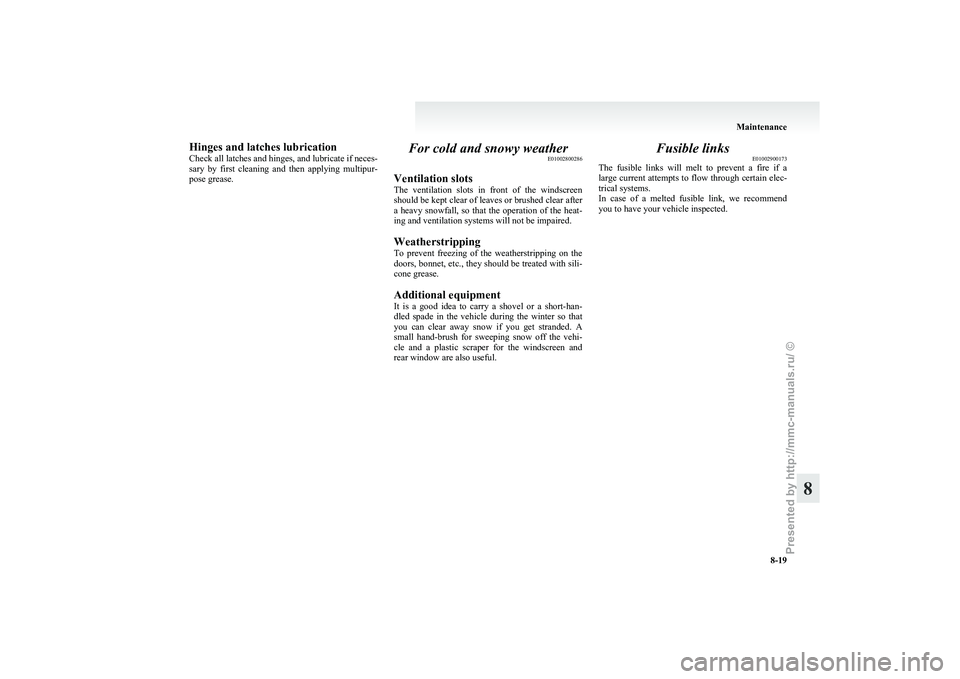
Hinges and latches lubrication
Check
all latches and hinges, and lubricate if neces-
sary by first cleaning and then applying multipur-
pose grease. For cold and snowy weather
E01002800286
Ventilation slots
The
ventilation slots in front of the windscreen
should be kept clear of leaves or brushed clear after
a heavy snowfall, so that the operation of the heat-
ing and ventilation systems will not be impaired.
Weatherstripping
To prevent freezing of the weatherstripping on the
doors, bonnet, etc., they should be treated with sili-
cone grease.
Additional equipment
It is a good idea to carry a shovel or a short-han-
dled spade in the vehicle during the winter so that
you can clear away snow if you get stranded. A
small hand-brush for sweeping snow off the vehi-
cle and a plastic scraper for the windscreen and
rear window are also useful. Fusible links
E01002900173
The
fusible links will melt to prevent a fire if a
large current attempts to flow through certain elec-
trical systems.
In case of a melted fusible link, we recommend
you to have your vehicle inspected. Maintenance
8-19 8
Presented by http://mmc-manuals.ru/ \251
Page 229 of 273
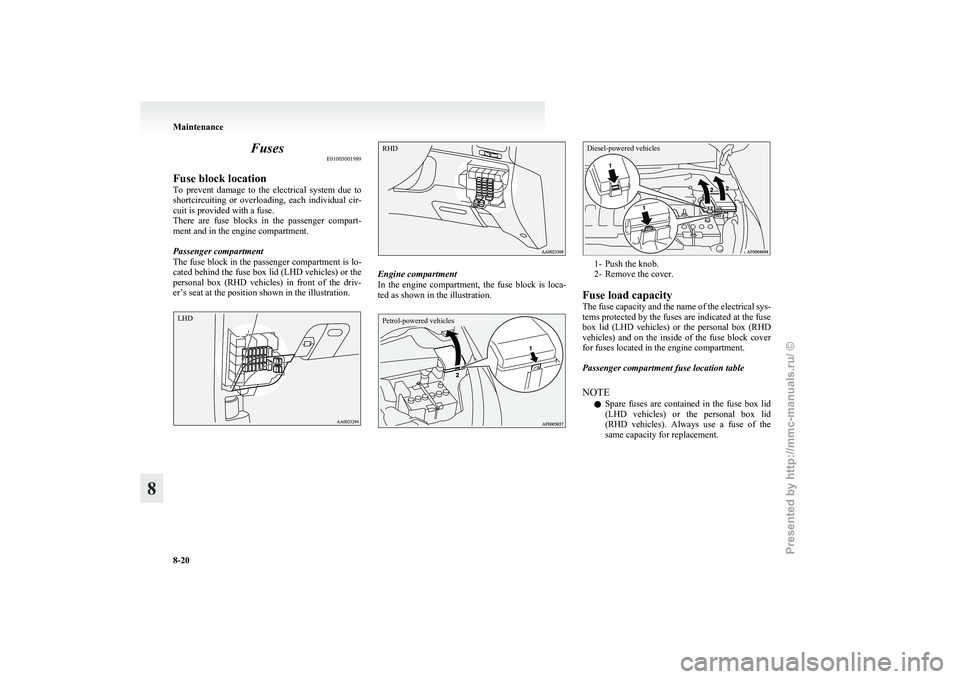
Fuses
E01003001989
Fuse block location
To
prevent damage to the electrical system due to
shortcircuiting or overloading, each individual cir-
cuit is provided with a fuse.
There are fuse blocks in the passenger compart-
ment and in the engine compartment.
Passenger compartment
The fuse block in the passenger compartment is lo-
cated behind the fuse box lid (LHD vehicles) or the
personal box (RHD vehicles) in front of the driv-
er’s seat at the position shown in the illustration. Engine compartment
In
the engine compartment, the fuse block is loca-
ted as shown in the illustration.
Petrol-powered vehicles
Diesel-powered vehicles 1- Push the knob.
2-
Remove the cover.
Fuse load capacity
The fuse capacity and the name of the electrical sys-
tems protected by the fuses are indicated at the fuse
box lid (LHD vehicles) or the personal box (RHD
vehicles) and on the inside of the fuse block cover
for fuses located in the engine compartment.
Passenger compartment fuse location table
NOTE l Spare fuses are contained in the fuse box lid
(LHD vehicles) or the personal box lid
(RHD vehicles). Always use a fuse of the
same capacity for replacement. Maintenance
8-20
8LHD RHD
Presented by http://mmc-manuals.ru/ \251
Page 230 of 273

Passenger compartment fuse location (LHD)Passenger compartment fuse location (RHD)No. Symbol Electrical system Capaci-
ties
1 Ignition coil 10 A
2 Gauge 7.5 A
3 Reversing lamp 7.5 A
4 Cruise control 7.5 A
5 Relay 7.5 A
6 Heated door mirror 7.5 A
7 Windscreen wiper 30 A No. Symbol Electrical system Capaci-
ties
8 Engine control 7.5 A
9 Accessory socket 15 A
10 — ——
11 Outside rear-view
mirrors 7.5 A
12 Engine control 7.5 A
13 — ——
14 Rear window wiper 15 A
15 Central door locks 15 A
16 Rear fog lamp 10 A
17 — ——
18 — ——
19 Heater 30 A
20 Rear window demis-
ter 30 A
21 Sunroof 20 A
22 Heated seat 20 A
23 Rear air conditioning 20 A
24 Starter 10 A
25 — Spare fuse 30 A
26 — Spare fuse 20 A
27 — Spare fuse 30 A Maintenance
8-21 8
Presented by http://mmc-manuals.ru/ \251